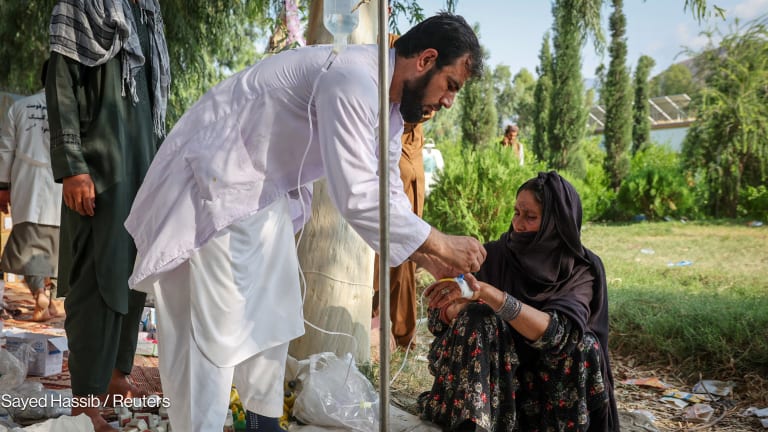
A few months ago in Cap Haitian, aid officials gathered at the behest of the Inter-American Development Bank to discuss ways to harmonize their efforts to rebuild the country after a devastating earthquake.
They goal was to find ways to better assess the effectiveness of international relief efforts by streamlining monitoring and evaluation. More meeting followed as the quake’s third anniversary neared – on common indicators, measuring processes and the use of technology, especially geographic information systems.
Today, on the eve of the quake’s Jan. 12 anniversary, questions about aid effectiveness remain. Haiti has seen the most massive influx of NGOs and other development-focused groups imaginable over the past three years, and although much has changed, aid has been flowing more slowly than expected and some observers continue to ask whether the country wouldn’t be better off with fewer - yet better coordinated - institutions than those which continue to crowd the streets of Port-au-Prince and its surroundings.
It’s a tough call, to be sure. Relief for the victims of the quake, flooding and ensuing cholera scares was sorely needed - and the cash-strapped Haitian government, which after the closure of the Interim Haiti Recovery Commission last year is now in the driver’s seat of the country’s development, still relies heavily on it.
But the continued focus on humanitarian relief is “conflicting with economic development,” one representative from a major U.S. consulting firm tells Devex.
Economic development has been hampered by persistent security concerns, which has kept many foreign investors at bay and aid workers scared to mingle, especially in the capital. Over the past few weeks, several of Haiti’s top bilateral donors have issued travel warnings. A Dec. 28 travel advisory from the U.S. State Department, for instance, noted that Americans arriving in Haiti were attacked and robbed shortly after leaving the airport and at least two U.S. citizens were killed in robbery and abduction incidents last year. Many top aid officials don’t leave their splendid homes in Port-au-Prince without armed escorts.
“Security issues affect our work in that they disrupt plans and create delays in program implementation,” Holly Frew, a media relations manager with World Vision, told Devex after garnering feedback from her colleagues working in Haiti. “They also create an atmosphere of fear that impacts the staff (both national and international) requiring an investment in security that could have been used for improving communities’ lives. Security issues discourage external investments that are necessary to complement the NGOs, government of Haiti and other actors efforts to improve the lives of millions of children and communities in Haiti.”
In a press conference last week, Haitian Prime Minister Laurent Lamothe complained about the travel advice, saying it would undermine the government’s efforts to rebuild the tourism industry and attract foreign investment.
“With the meager resources that the state has, we’re investing in tourism,” he said.
Haiti will remain in dire need for international assistance. An array of issues need urgent attention, not just the relocalization of people still living in camps.
“In many of the areas that we have been working, we have noticed a severe decrease in agricultural productivity, caused by land degradation and by recurrent hurricanes. That has resulted in major food production shortfalls throughout the country,” Frew said. “This situation we feel is one that an issue that has not been properly addressed and needs urgent attention. Any long-term plan for a successful population able to flourish on their own needs to include a way for parents to feed their families with dignity.”
To be sure, there’s good news to report from Haiti as well. A new study backed by the United Nations indicates substantial progress in the sectors of education, nutrition, health and sanitation over the last few years.
The initial results of the Haiti Demographic and Health Survey, which covered 13,350 households, show that 77 percent of children aged 6-11 attended primary school in 2012, up from 50 percent in 2005-2006. Acute malnutrition among children aged 6-59 months went from 10 percent in 2005-2006 to 5 percent in 2012, and under-5 mortality from chronic malnutrition from 29 percent to 22 percent over the same period.
“These findings call for a continued commitment to support the country in sustaining this success while addressing existing challenges and where progress has lagged,” Edouard Beigbeder, UNICEF representative in Haiti, said Jan. 10.
The results from the study may prove a balm to the aid community in Haiti. Some have criticized the pace of the recovery and rebuilding efforts, pinning much of the blame on international relief agencies.
While not all of the criticism is without merrit, it may have been partly inspired by inflated expectations in the wake of overwhelming international generosity from both public and private donors following the disaster. The post-quake motto to “build back better” a country that had been reeling from civil war and mismanagement for decades was never supposed to be a short-term project. It still isn’t.
Eliza Villarino contributed reporting.
Read more development aid news online, and subscribe to The Development Newswire to receive top international development headlines from the world’s leading donors, news sources and opinion leaders — emailed to you FREE every business day.








